
Lidocaine (lignocaine) has been commonly used as a local dental anaesthetic since 1948. It provides pulpal anaesthesia for about 1 hours and soft tissue anaesthesia for 3-5 hours. Articaine was introduced in the mid 1970s and is more lipid soluble, which has been linked with a faster onset, and higher success rate compare with Lidocaine. The aim of this review was to compare the efficacy of articaine with lignocaine in patients with symptomatic irreversible pulpitis who are undergoing endodontic treatment,
Method
Searches were conducted in the PubMed Scopus, Cochrane Library and ClinicalTrials.gov databases. Randomised, double-blind clinical trials that evaluated anaesthetic solutions of 4% articaine compared with 2% lidocaine, delivered as a similar volume dose of at least 1.0 mL per injection in combination with vasoconstrictor, in adult patients with symptomatic irreversible pulpitis were considered. Non-English language articles without English abstracts were excluded.
Two independent reviewers assessed the eligibility for inclusion and quality. The primary outcome measure was the reduction of pulpal pain to a level that would allow endodontic treatment to proceed within 20 minutes of administration of local anaesthetic, as defined by each trial and electric pulp tests and/or by initiating endodontic treatment procedures. Meta-analysis was performed on all data obtained by using any maxillary and mandibular anaesthetic delivery route combined and Maxillary anaesthesia and Mandibular anaesthesia subgroups. The principal summary measures were odds ratios (ORs) calculated by using a random-effects model.
Results
- 10 studies involving 746 adult patients were included.
- Trials were conducted in Brazil, England, India and the United States.
- There was considerable methodological heterogeneity between studies e.g. location of teeth being anaesthetised (maxilla or mandible, anterior or posterior), tooth type (molars, premolars, or anterior teeth), volume of anaesthetic solution administered, and delivery route.
- Success rates for articaine and lidocaine ranged from lows of 24% and 23%, respectively, for inferior alveolar nerve block delivery to 100% and 89%, respectively, for maxillary infiltration.
- For combined studies, articaine was more likely than lidocaine to achieve successful anaesthesia: odds ratio (OR) = 2.21; 95% CI; 1.41–3.47; P = .0006; I2 = 40%.
- For maxillary infiltration subgroup, there was no significant difference between articaine and lidocaine OR, = 3.99; 95%CI; 0.50–31.62; P = .19; I2 = 59%)
- For combined mandibular anaesthesia studies that used any delivery route, articaine was superior to lidocaine OR = 2.20; 95% CI; 1.40–3.44; P = .0006; I2 = 30%)
- Subgroup analysis showed no difference when used for mandibular block anaesthesia alone OR = 1.44; 95% CI; 0.87–2.38; P = .16; I2 = 0%)
- When used for supplemental infiltration after (successful) mandibular block anaesthesia, articaine was significantly more effective than lidocaine OR = 3.55; 95% CI; 1.97–6.39; P < .0001; I2 = 19%).
- Analysis suggest that publication bias may be present.
- Studies comparing articaine and lidocaine delivered by intraosseous, intraligamental, and intrapulpal routes were not identified.
Conclusions
The authors concluded:
The present meta-analysis showed that in patients with symptomatic irreversible pulpitis, articaine is as effective as lidocaine when used for mandibular block or maxillary infiltration anesthesia. In cases of persistent pulpal pain despite successful mandibular block anesthesia, supplementary infiltration with articaine instead of lidocaine has 3.55 times greater likelihood of achieving successful anesthesia.
Comments
This well conducted review found a significant advantage for using articaine over lidocaine for supplementary infiltration after mandibular block but no other advantages. The authors highlight the heterogeneity in the studies, which related from a wide range of factors, geographic location, sample size, number and experience of operators, potential variations in diagnosis of symptomatic irreversible pulpitis (cold test, electric pulp test, and patient history), the volume of anesthetic, the concentration of epinephrine, reproducibility of injection route, and evaluation scale used to assess pain and definition of success. They also point to the potential that publication bias could be present, which could lead to an over estimation of the effect.
A Cochrane review of local anaesthetic agents for dental anaesthesia is underway.
Links
Original review protocol on PROSPERO
Kung J, McDonagh M, Sedgley CM. Does Articaine Provide an Advantage over Lidocaine in Patients with Symptomatic Irreversible Pulpitis? A Systematic Review and Meta-analysis. J Endod. 2015 Aug 17. pii: S0099-2399(15)00600-7. doi:10.1016/j.joen.2015.07.001. [Epub ahead of print] Review. PubMed PMID: 26293174.
St George G, Hussain S, Meechan J, Moles DR, Needleman I. Injectable local anaesthetic agents for operative dental anaesthesia (Protocol). Cochrane Database of Systematic Reviews 2007, Issue 2. Art. No.: CD006487. DOI: 10.1002/14651858.CD006487.

Articaine better than lidocaine for supplementary infiltration after mandibular block anaesthesia http://t.co/K6vzntPNaT